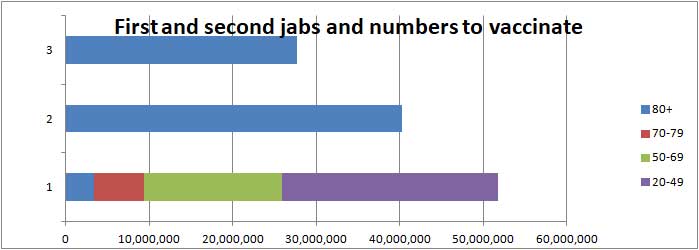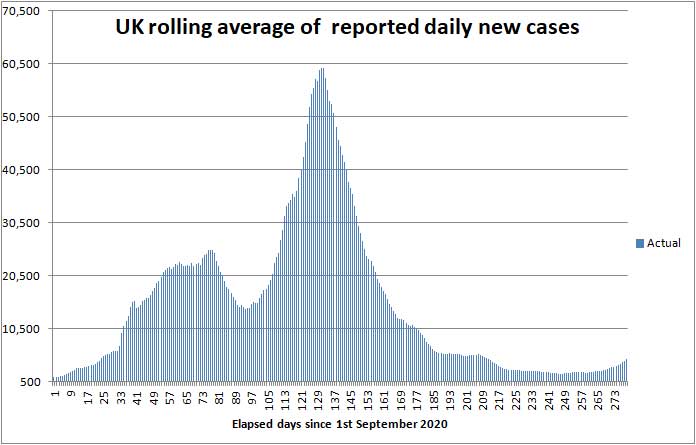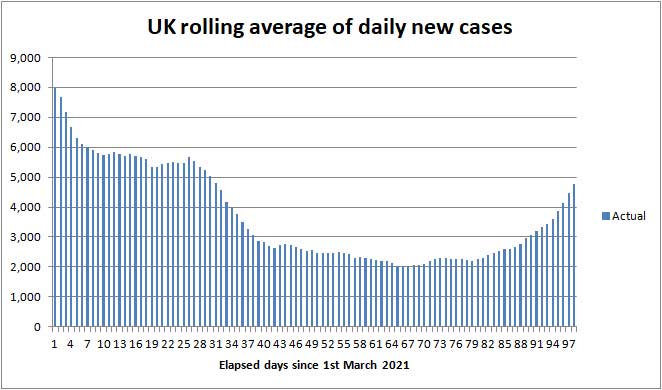
Angus and Rosemary's Miscellany
of Malvern - Other Resources
|
Coronavirus (COVID-19) epidemic weekly update for Malvern Seniors6th June 2021 COVID LOCKDOWN in ENGLAND EXIT STEP 3, DAILY CASES RISING IN HOTSPOTS Risk remains low within the Malvern Hills district Skip to menu of archived pages PreambleWe keep an eye on the published government figures and monitor the media to asses the level of risk for Seniors in the Malvern Hills district. This page is normally updated every Sunday between 1800 and 2400 hours GMT. Information about Coronavirus can be found on the NHS website: https://www.nhs.uk/coronavirus
|
| Districts of Worcs | Cases | Weekly increase | Population |
| Bromsgrove | 6,295 | +18 | 98,529 |
| Malvern Hills | 2,840 | +7 | 77,545 |
| Redditch | 6,312 | +40 | 85,317 |
| Worcester | 6,247 | +24 | 103,542 |
| Wychavon | 6,484 | +12 | 126,240 |
| Wyre Forest | 5,621 | +21 | 100,957 |
| TOTAL | 33,799 | +122 | 592,130 |
| COMPARE WITH | |||
| County of Hereford | 7,206 | +43 | 195,000 |
| Leicester (city of) | 37,911 | +358 | 400,000 |
Cumulative cases reported by PHE in Worcestershire to 6th June 2021
The weekly increase is indicative; the seven day average by area, which varies day to day, is an alternative metric that can be found on the Coronavirus dashboard.
Though daily cases in Leicester have dropped considerably from their peak, cases have doubled in the last three weeks.
Interactive map
At the bottom of the Coronavirus Dashboard (daily update) page there is an Interactive Map which is coloured to show the variation in infection rate across the country.
More of the map is turning from yellow to pale green suggesting infection rates have been creeping up across the country. There are hotspots particularly around Blackurn, Bolton and Manchester in the NW; also Bedford, South Ayrshire, Glasgow, Edinburgh and Dundee.
Click for Interactive Map of COVID cases
Note: the Interactive Map works on desktop PCs but it's possible you may encounter difficulties using a tablet or smartphone.
New cases in Malvern are currently too low to register on the map, except for Malvern Wells and Priory where 7 cases were reported, and North Malvern where 3 cases were reported, in week ending 1st June.
Number of deaths
Statistics on COVID deaths are published by Public Health England, The Office of National Statistics, and NHS England.
PHE figures
Public Health England reports that the cumulative total of COVID (28) deaths in UK hospitals and care homes has risen by 59 in the last week to 127,840 while the daily average has flat-lined at about 8 deaths per day.
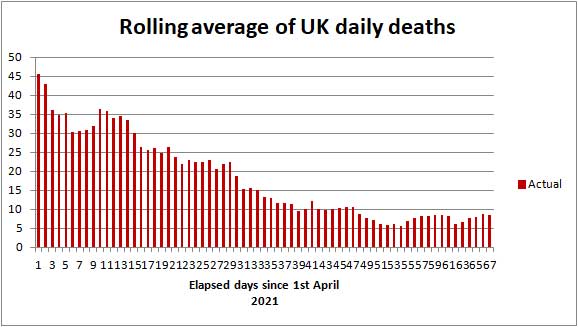
COVID-19 death rate 1st April to 6th June 2021
Click to view the UK government Coronavirus Dashboard
In comparison averaged over recent years 1,700 people die daily from all causes.
ONS figures
The Office of National Statistics (ONS) separately reports registered deaths in England and Wales where COVID-19 is mentioned on the death certificate. The ONS figures lag the PHE figures by 10 - 14 days and do not include Northern Ireland and Scotland.
The ONS figures are broken down by District providing a glimpse of where deaths are occurring. The provisional cumulative total of COVID related deaths in Worcestershire reported by the ONS up to 21st May 2021 (week 20 of 2021) is shown below.
Note: the numbers are from the ONS Death Registrations-Pivot table
| Districts of Worcs | Deaths 2020 |
Deaths 2021 |
Week 20 | Population |
| Bromsgrove | 164 | 101 | 0 | 98,529 |
| Malvern Hills | 61 | 83 | 0 | 77,545 |
| Redditch | 108 | 85 | 0 | 85,317 |
| Worcester | 87 | 115 | +1 | 103,542 |
| Wychavon | 157 | 119 | +1 | 126,240 |
| Wyre Forest | 171 | 104 | 0 | 100,957 |
| TOTAL | 748 | 607 | 0 | 592,130 |
Provisional cumulative COVID-19 deaths registered by ONS to 21st May 2021
In the last week there has been one COVID death in a care home in Worcester, and a death in hospital in Wychavon.
In England and Wales 107 COVID-19 related deaths were reported by the ONS in the week to 21st May; 22 less than reported a fortnight ago. Of these 20 were in a care home, 19 at home, 2 in a hospice, 64 in hospital and 2 elsewhere.
The provisional COVID-19 death toll for all weeks of the epidemic is shown in the following table for England and Wales.
| Year | Provisional COVID-19 UK death toll in England and Wales |
| 2020 | 80,741 |
| 2021 | 57,338 |
| TOTAL | 138,079 |
COVID-19 death toll in England and Wales to 21st May 2021 (source: ONS)
Note: summation of rows 9-344 of ONS Registrations-Pivot Table spreadsheet tab.
The UK death toll is about 10% higher as deaths for Scotland and Northern Ireland have to be added.
Click for national ONS data on deaths (Excel spreadsheet)
The death toll based on death certificates is about 20% higher than deaths within 28 days reported by PHE.
NHS England figures
The table below shows latest COVID deaths in Worcestershire hospitals reported by NHS England to 5th June.
| Worcestershire | Cumulative deaths | Past fortnight |
| Acute hospitals | 808 | +2 |
| Care hospitals | 63 | 0 |
| TOTAL | 871 | +2 |
Click for NHS COVID-19 Daily Deaths
Healthcare numbers
The UK government Coronavirus Dashboard includes important information about healthcare statistics.
| Hospital cases (UK) | Number | Change in past fortnight |
| Patients currently in hospital | 932 | +24 |
| Patients on ventilation | 134 | +11 |
| Patients admitted daily | 154 | +32 |
Headline summary of patients in hospital as reported 6th June 2021
The number of COVID-19 patients in hospital, and the number on ventilators has roughly flat-lined in recent weeks.
Daily hospital admissions expressed as a 7 day average fell to 100 about 20th May but has crept up to 130 and can be expected to increase further as a result of new cases. Previously hospitals only admitted very sick COVID patients and it could be less sick patients are now being admitted.
In the past, the steady state number of COVID patients in hospital has been roughly ten time the number of patients admitted daily. This ratio should fall as fewer patients require intensive care and are discharged earlier due to vaccination.
Last year roughly 10% of new cases were admitted to hospital and of those at least 1 in 5 died.
The latest figures suggest about 5% of new cases are being admitted to hospital. If it is assumed that due to vaccination just 1 in 15 of these now dies then 122 hospital admissions per day may suggest up to 8 UK deaths per day by the middle of June.
Note: these ratios are very rough and ready and should change as more of the population is vaccinated.
Tabulated figures for bed occupancy in Worcestershire Acute and Care hospitals can be found on the NHS England website.
Click for NHS England COVID-19 Hospital bed Activity
You can also obtain a snapshot of bed occupancy from the Coronavirus Dashboard daily update page, by entering your postcode at the bottom of the page, which will show data for Worcestershire; then find and click All Health Data to see bed occupancy. This information has returned to the Worcestershire Coronavirus Dashboard.
Click to view Worcestershire Coronavirus Dashboard.
Recently there have been 9 COVID patients in Worcestershire Acute Hospitals of which one was on a ventilator; one more than a fortnight ago.
The main point to note is that the number of Worcestershire COVID-19 beds occupied is very much lower than the peak of about 300 beds.
Forecast for the week ahead
Trends suggest that during the next seven days (up to 13th June) the cumulative total of new UK COVID-19 cases reported by PHE on the Coronavirus Dashboard could increase by up to 42,000 towards 4,522,000 followed by a consequential increase in daily hospital admissions.
In Worcestershire 120 new cases of COVID-19 can be expected, and possibly up to 12 cases in the Malvern Hills district.
We estimate the number of COVID (28) deaths will increase by about 60 nationally towards 127,900 during the 7 days ending 13th June 2021.
In the county of Worcestershire, assuming a 0.3% death rate, the 122 new cases this week should translate to no more than one COVID death per month in June/July.
Longer term forecast
Commentators have suggested that the UK could be approaching herd immunity due to both the success of the vaccination programme, and immunity of those who have already been infected by COVID-19.
The huge flare up of cases in Bolton casts some doubt on this and suggests a higher level of vaccination will be needed to counter Indian Coronavirus. Matt Hancock says most of those in hospital in Bolton had been offered the vaccine but had not taken it.
The chart below shows how daily cases could further increase up to 21st June if the present exponential rise in cases amongst the unvaccinated is maintained.
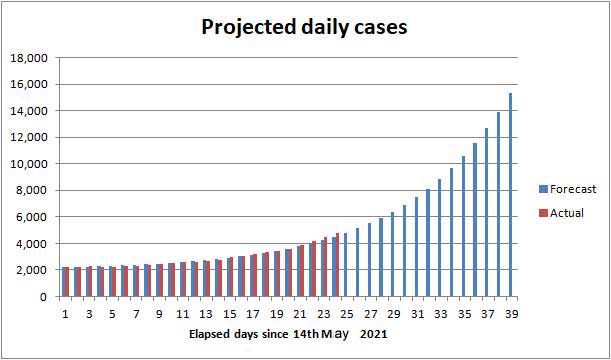
Actual and projected UK daily cases to 21st June
Were the rise this steep, the government might be forced to delay exit from lockdown until after the 21st June in order to vaccinate more of the population.
Remember that currently only 59% of the UK population has received a first COVID vaccination and only 40% have had two jabs, so there is more work to do.
Scientists warn against letting new cases 'rip' as the virus would quickly 'weed out' the frail and unvaccinated.
Advice for Seniors
 The
daily number of new cases of Coronavirus has fallen a long way from
the peak of the third wave so we judge the risk to be LOW for most Seniors
in the Malvern Hills district who have had 2 jabs;
see our annex and riskometer opposite.
The
daily number of new cases of Coronavirus has fallen a long way from
the peak of the third wave so we judge the risk to be LOW for most Seniors
in the Malvern Hills district who have had 2 jabs;
see our annex and riskometer opposite.
But remember, if you are elderly, have not been vaccinated, and were to catch COVID there is a significant chance that you will either die or your long term health may be seriously damaged, so get your vaccine and continue to take care of yourself and those you love. 90% of COVID deaths have been in those aged over 60 years according to NHS England statistics.
Click for our risk of death table (for those who have not been vaccinated)
It's possible, despite a second jab, for some Seniors to become ill with COVID, though for most this is likely to be a mild illness.
The simple safeguards to remember are to:
-
wash your HANDS thoroughly, using soap and hot water, for 20 seconds, including after handling deliveries to your home, to kill virus picked up from contaminated surfaces see note 1;
-
wear a FACE mask when unavoidably near other people for example when shopping, visiting hospital or the chemist, and using public transport;
-
SPACE at least 2 metres from people outside your bubble see note 2;
-
preferably meet friends and other households outdoors in the FRESH AIR, else keep the windows open if you are indoors;
-
minimise TIME near strangers;
-
self-isolate and book a test if you have COVID-19 symptoms (new continuous cough, fever or loss of, or change in, sense of smell or taste).
-
keep away from areas where the infection rate is known to be high.
Hence the PMs mantra:-
HANDS, FACE, SPACE, FRESH AIR
We are moving from a regime where the government tells us what to do to one where it is up to us to take personal responsibility for assessing the risk to ourselves and our loved ones.
Remember, if you have symptoms of COVID-19 at home and can't count from one to ten out loud due to shortness of breath, you should immediately call your GP, 111 or 999 for advice.
Click for UK government Coronavirus guidance on what you can and cannot do
Notes:
1) Wash your hands thoroughly before touching your face to avoid transferring virus from contaminated surfaces to your mouth, eyes and nose. If outdoors use hand gel.
2) Two metres is further than you think - roughly an arm and a walking stick away.
3) If possible keep windows and doors open to improve ventilation when meeting others.
4) If you have been vaccinated and are infected by COVID-19 you may not get the classic symptoms; you could for example have no symptoms or feel like you have a common cold. If in doubt get a test.
Japanese advice has been to avoid the three Cs, see poster below:
-
Crowded spaces with poor ventilation
-
Crowded places with many people nearby
-
Close-contact settings such as close range conversations
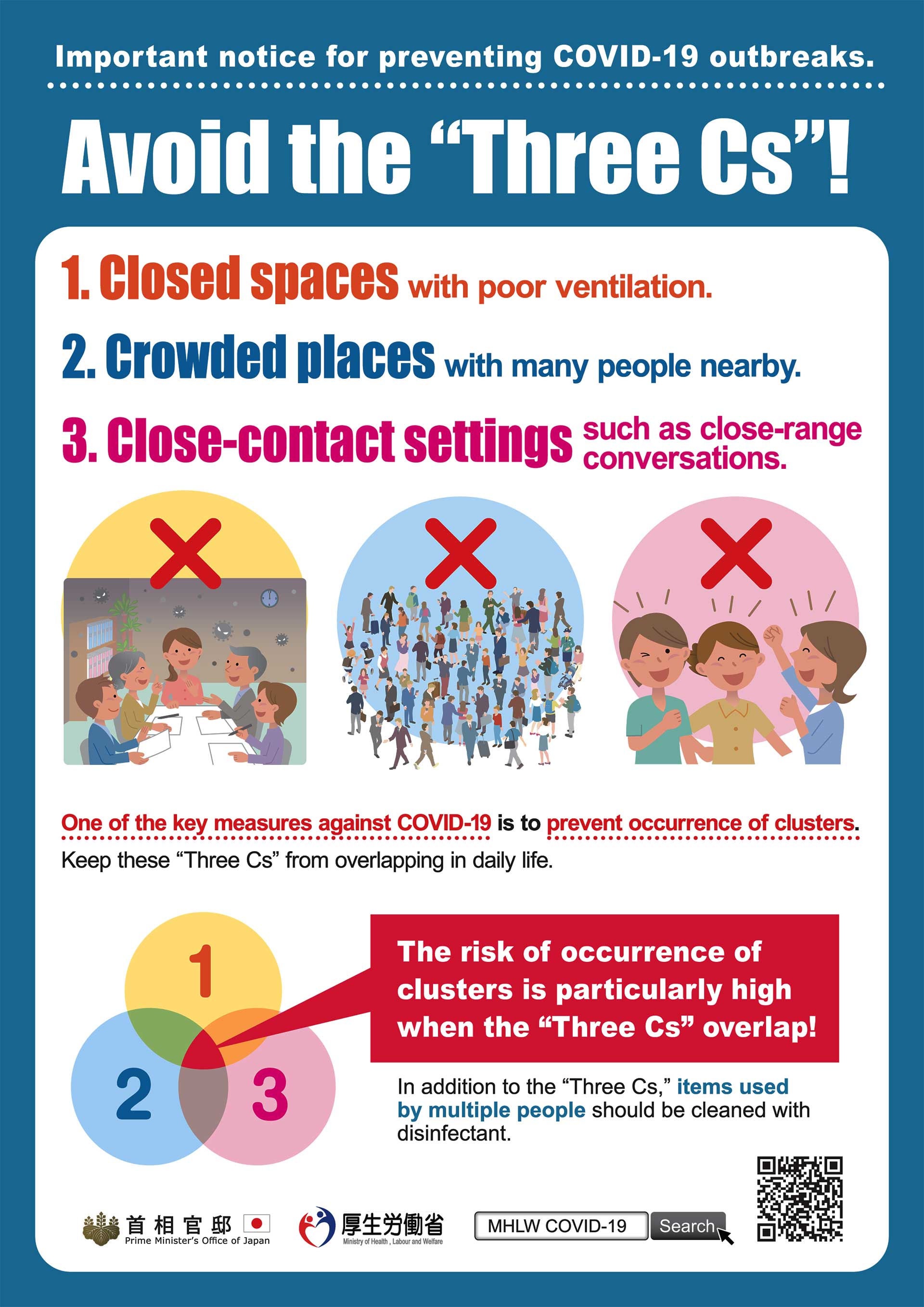
COVID advice in Japan
Most of us who have received two jabs probably now feel safe mingling with friends and family!
Annex to 6th June update
Commentary
On Tuesday 25th May the government issued stay local advice for areas such as Bolton where the Indian variant of COVID has begun to spread rapidly.
Austria banned direct flights from the UK from 1st June to keep out the Indian variant.
On Wednesday 26th Germany and France announced travellers from the UK would have to quarantine for 10 days. That weasel Dominic Cummings went before Health and Science Committees and slagged off the PM and Matt Hancock - he didn't seem to have anything new or useful to contribute.
Although on the green list, Singapore has gone into a new lockdown due to low-level community transmission which can't be explained. Visitors from the UK may have to quarantine for 3 weeks.
On Thursday 27th Matt Hancock gave a briefing on the new COVID hotspots and update on the vaccination programme.
Click for Matt Hancock's statement on 27th May
On Friday 28th the single dose Janssen vaccine was approved by the UK; 20M doses are now on order. The EU approved the Pfizer vaccine for 12-15 year olds. Sky News sadly reported BBC presenter Lisa Shaw aged only 44 years had died from suspected blood clots following vaccination with the Astrazeneca jab.
Malvern was busy during the sunny Spring Bank Holiday weekend but we guess on this occasion relatively few people flew abroad compared to the Autumn Bank Holiday.
On Thursday 3rd June Portugal was moved to the 'amber list' and there was vague mention of a new Nepal variant.
On Friday the UK approved the Pfizer vaccine for 12 - 15 year olds.
Spain announced tourists who have had two jabs would be welcomed.
On Saturday France announced UK tourists who have had two jabs would be welcomed.
Click for Guardian report France to allow UK tourists to enter if fully vaccinated
On Sunday Matt Hancock appeared on the Andrew Marr show after being interviewed by Trevor Phillips for Sky News. He said the Indian variant had been assessed 40% more transmissible, the link with hospitalizations and deaths had been severed by the vaccines but not completely broken and that the vaccines would be offered to under 30s next week.
We haven't heard mention of a reproduction rate for the new variants of COVID-19 but were it to be as high as 8, then vaccination of 90% of the population with two jabs would be needed to be sure of achieving herd immunity, and at present rates that might not be achieved in the UK until towards the middle of August 2021.
Overseas travel
The situation is confused and could remain so until the world is more fully vaccinated.
The UK government would rather people did not travel overseas this year, but the regulations do not prevent it. The main question is will the country you want to visit let you in.
Returning travellers to the UK must quarantine according to the UK Traffic Light system (see below).
Travellers should take account of Foreign, Commonwealth & Development Office advice and check, in the light of this, whether their travel insurance will cover the intended journey.
If you are planning to go on an overseas holiday, you should check things out extremely carefully, ideally make bookings that can be changed, and be prepared to quarantine if circumstances change.
The UK 'Traffic Light' system specifies the quarantine measures those entering the UK from abroad must undergo.
Click for guidance on travel during the COVID pandemic
Click for Report of the Global Travel Taskforce - The Safe Return of International Travel
In essence the plan is that you will need to pass a COVID test before being allowed to fly back to the UK and take another test upon arrival. If you return from a 'green' list country you are free to circulate if both tests are clear. If you return from an 'amber' list country you must quarantine for ten days and take two COVID tests following arrival. If you arrive from a red list country you must quarantine for ten days in an approved government hotel and take two tests booked before departure.
Click for Red, Amber and Green list rules for entering England
The cost of getting tests is likely to be a significant burden on travellers, who may also have to provide evidence of vaccination for example by either providing a vaccination certificate or by means of the NHS app on their smartphone.
Note: this is not the NHS COVID-19 app
Click for NHS info on Coronavirus vaccination status for travelling abroad
The situation is fast moving. France, Spain and Portugal now appear keen to attract vaccinated British tourists, and is it really necessary for vaccinated individuals to have to quarantine on return to the UK?
List of vaccines
Here is the list of vaccines ordered by the UK - you will see there is plenty of vaccine in the pipeline for delivery later in the year.
| COVID-19 vaccine | Doses ordered (million) | Status |
| Pfizer BioNTech, two dose, -70 deg C | 40+60 | Approved, deliveries continuing, made in Belgium (EU). An additional 60M doses have been ordered for booster shots for the most vulnerable in the autumn. |
| Astrazeneca, two dose, fridge | 100 | Approved for those aged 30+ years; deliveries continuing. Batches made in UK, Belgium and India. |
| Moderna, two dose, -20 deg C | 7+10 | Approved. First deliveries to Wales and Scotland 7th April 2021 then England 13th April; mainly for those aged under 50 years awaiting vaccination. |
| Valneva, two dose | 60+40 | A jab from French company Valneva will be made in Livingston, West Lothian, Scotland. Delivery to start in second half of 2021. |
| Janssen, single dose | 20 | Approved, a jab from Belgian firm Janssen, owned by Johnson and Johnson; UK approval 28th May. Order reduced from 30 to 20M. |
| Novavax | 60 | A jab manufactured by US firm Novavax is being made in Stockton-on-Tees UK; phase III trials complete, awaiting approval. Should be available later this year. Glaxo Smith Kline (GSK) has been contracted to fill and package vials. |
| GSK Sanoft | 60 | Some delay due to adjusting the formula to give better protection to the elderly; possible availability late 2021. |
| Curevac | 50 | Contract placed with German company Feb 2021. Possible source of new variant vaccine later in 2021 |
Table of vaccines ordered by the UK government
Present rate of new cases and risk
The average rate of infection per 100,000 population per week in England has risen from 21 to 37. In comparison the figure for Worcestershire and the Malvern Hills is 21, while Bolton is 354 and Blackburn 487.
The probability of catching Coronavirus in the Malvern Hills district remains low, and as most Seniors have been vaccinated with 2 jabs we judge the risk LOW.
The risk of death from Coronavirus for unvaccinated children and healthy teenagers is small so for them the risk is also LOW. The middle aged can suffer from debilitating Long COVID so for those that have not been vaccinated and may be visiting areas where rates are spiking, such as Bolton, the risk might be judged MODERATE to HIGH.
About the final UK COVID-19 death toll
At the start of the epidemic on 17th March 2020 the Chief Scientific Adviser, Sir Patrick Valance, questioned by the Health Select Committee, did not disagree with Jeremy Hunt's suggestion that a death toll of 20,000 might be a reasonable outcome.
On the other hand, Professor Neil Ferguson of Imperial College warned in some scenarios the death toll might be as high as 250,000; while we thought, in the very worst case assuming up to 1% of the UK population died the outcome might have been nearer 400,000 taking into account some build up of herd immunity.
So how well will the UK have done? When Jeremy Hunt and Sir Patrick Valance spoke there had been few deaths and they clearly underestimated what was to come. Professor Neil Ferguson was nearer the mark. A few might consider an outcome of about 128,000 deaths a fair result compared to a greater number of people dying in a very short space of time, more being permanently disabled by Long COVID, temporary collapse of the NHS and patients dying at home or queued in ambulances outside hospitals. You have only to look at the recent situation in India to imagine what could have happened.
Members of the Labour Party and others will no doubt say the UK has done poorly compared to the best performing countries such as Australia, New Zealand and Singapore where deaths have been much lower, not to mention the enormous expense of supporting those out of work and huge damage to the economy.
With hindsight, deaths might have been much lower if the second lockdown had been continued into December and January, but that would have meant cancelling Christmas, and who knows to what extent the public would have complied.
Worldwide, this pandemic is not played out and it could be a further 1 to 2 years before the 'dust' finally settles. The PM has promised an independent inquiry in Spring 2022 to learn lessons for the future.
Summary of Links
Symptoms
Article about the effects of Coronavirus on the human body
Reporting and how to obtain a test
How to get a test
https://www.nhs.uk/coronavirus
About joining the Zoe COVID Symptom Study:
Guidance
UK government Coronavirus guidance
Tiers
Guidance on tiers: what you need to know
Government postcode checker to find tier for other areas
Statistics
UK government Coronavirus Dashboard
Coronavirus Dashboard Interactive Map
ONS data on deaths in England and Wales (Excel spreadsheet)
NHS England COVID-19 Daily Deaths
NHS England COVID-19 Hospital Admissions
NHS England vaccination statistics
Worcestershire Coronavirus Dashboard
Worcestershire COVID-19 Vaccinations Dashboard
Reports
ONS Coronavirus (COVID-19) Roundup
The bigger picture
Worldometer summary of coronavirus cases worldwide
European Centre for Disease Prevention and Control info
https://www.ecdc.europa.eu/en/geographical-distribution-2019-ncov-cases
World Health Organisation info
Window on the USA
Centre for Disease Control (CDC)
American Association of Retired People (AARP)
Worcestershire
Help:
http://www.worcestershire.gov.uk/here2help
Worcestershire County Council COVID-19 information:
http://www.worcestershire.gov.uk/coronavirus
Here you will find a useful link,
'Website: Number of new cases by date in Worcestershire'
which displays interesting COVID charts and statistics for Worcestershire
Miscellaneous
Spanish Flu
Dr Jeff Kildea's commentary about the 1919 outbreak of Spanish Flu in Australia
Views of Martin McKee, Professor of European Public Health
Follow Martin McKee on Twitter
SAGE membership
Scientific Advisory Group for Emergencies (SAGE)
Scottish government:
Link to Scottish Government website
Link to Postcode checker for COVID restrictions by protection level in areas of Scotland
Welsh Government:
Guidance on COVID alert levels in Wales

The interpretations and opinions expressed are our own.
Last updated 8th June 2021
 Blogs
>
Blogs
>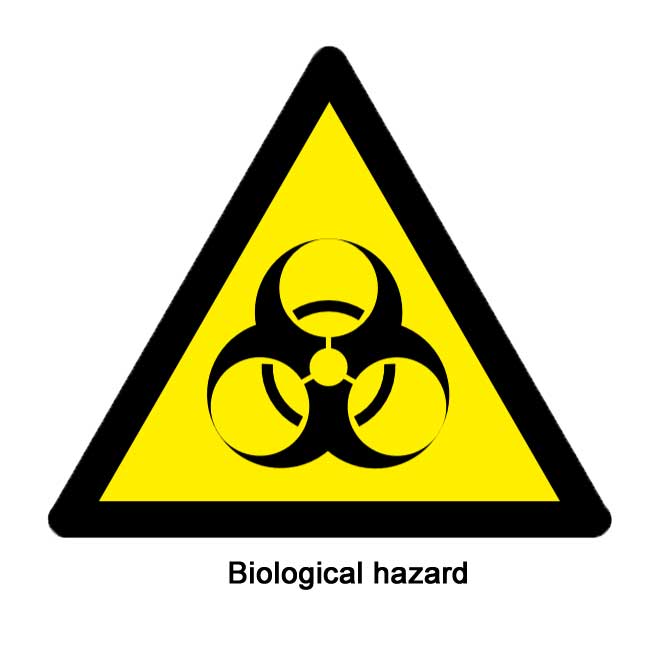 How
to request a COVID test
How
to request a COVID test Please
consider helping others by downloading the COVID Symptom Study app onto your
smart phone or Ipad and reporting how you feel either daily, or as you are
able. Note that currently there is no desktop PC version for Windows.
Please
consider helping others by downloading the COVID Symptom Study app onto your
smart phone or Ipad and reporting how you feel either daily, or as you are
able. Note that currently there is no desktop PC version for Windows.